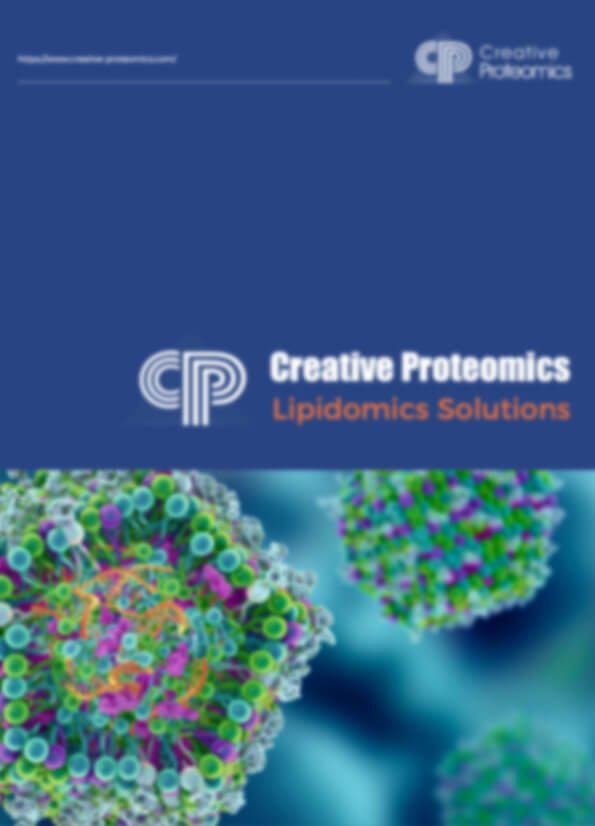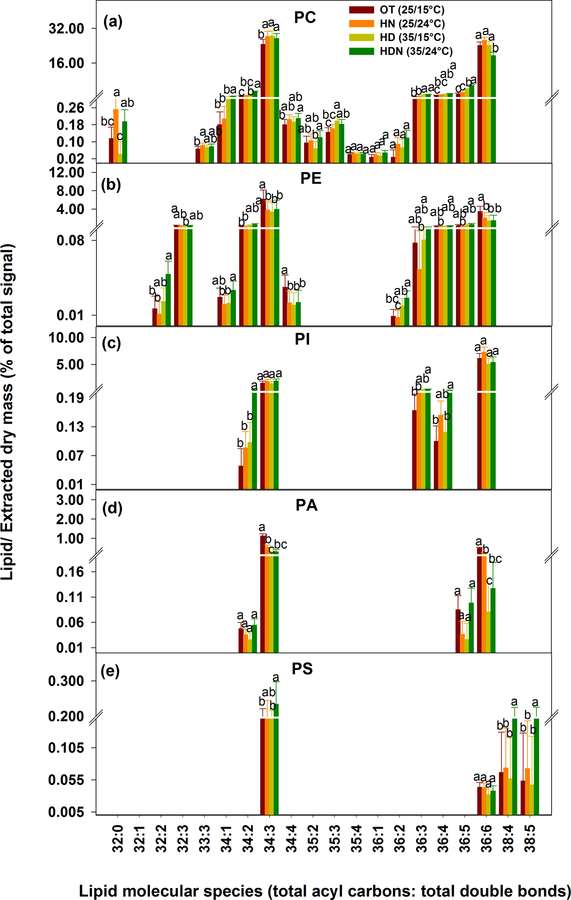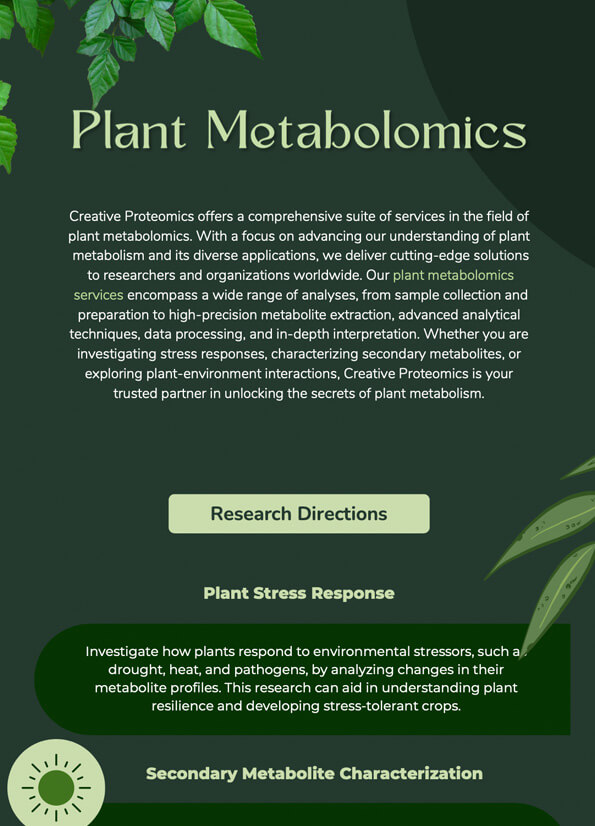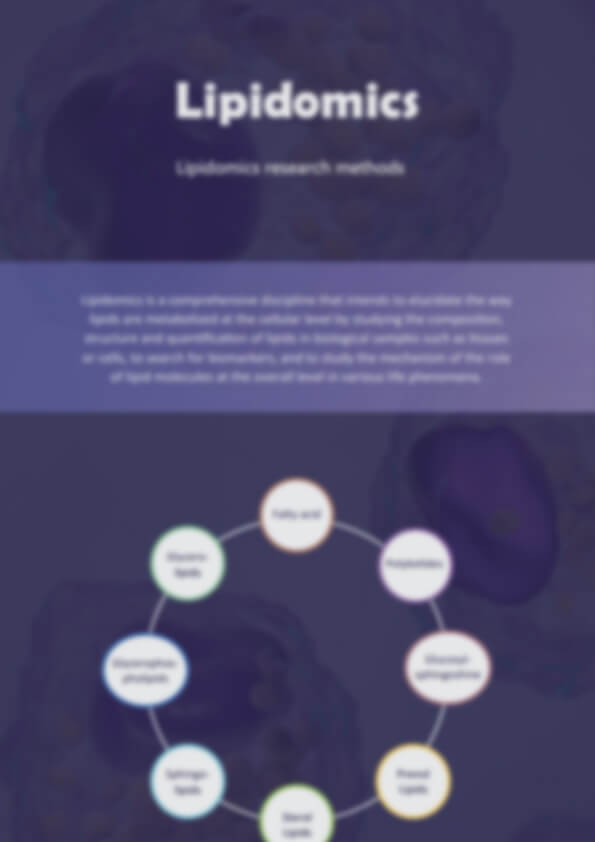Plant Untargeted Lipidomics Analysis Service
Creative Proteomics offers comprehensive plant untargeted lipidomics services, utilizing advanced LC-MS/MS and high-resolution mass spectrometry technologies to analyze a wide range of lipid species in plant samples. Our service provides detailed lipid profiling, including primary and secondary lipid metabolites, stress response analysis, and lipid metabolic pathway mapping. With customized extraction methods, high sensitivity, and a robust bioinformatics platform, we deliver accurate, reproducible results for plant research, biotechnology, and agricultural applications.
Submit Your Request Now
×- Define
- What We Provide
- List of cAMP Metabolites
- Technology Platform
- Advantages
- Sample Requirements
- Applications
- Demo
- FAQs
- Case
- Publications
What is Plant Untargeted Lipidomics?
Plant untargeted lipidomics refers to the comprehensive analysis of lipids in plant systems without any prior bias or targeting of specific lipid species. This method uses high-resolution analytical techniques to capture a full spectrum of lipid classes, from common fatty acids to complex phospholipids, sphingolipids, and other specialized lipid molecules. The "untargeted" nature of the analysis means that it allows for the detection of a wide array of lipids, including those that are novel or not previously studied.
Lipidomics in plants is essential for understanding how plants store energy, protect themselves from environmental stress, and communicate between cells. The identification of these lipids can help in areas such as agricultural development, biotechnology, and plant pathology.
What Specific Projects Does Creative Proteomics Offer?
- Comprehensive Lipid Profiling: Analysis of all lipid classes present in the plant samples, including primary lipids (e.g., fatty acids, glycerolipids) and secondary metabolites (e.g., sphingolipids, sterols).
- Lipid Class and Subclass Quantification: Accurate quantification of lipids from major classes such as phospholipids, galactolipids, and neutral lipids.
- Stress Response Lipidomics: Profiling lipid changes in response to environmental stressors (e.g., drought, salt, temperature fluctuations) or biotic stress (e.g., pathogen infection).
- Comparative Lipidomics: Comparative lipid analysis between different plant species, varieties, or experimental treatments to identify specific lipid biomarkers.
- Lipid Metabolic Pathway Mapping: Understanding lipid biosynthesis and degradation pathways, including key enzymes involved in lipid metabolism.
- Lipid Signaling: Investigation of lipids involved in cellular signaling, such as phosphoinositides, lysophospholipids, and eicosanoids.
Lipid Classes We Can Analyze
Monoglycerides (MG), Diglycerides (DG), Triglycerides (TG), Galactolipids (MGDG, DGDG), Acylglycerols
Phosphatidylcholine (PC), Phosphatidylethanolamine (PE), Phosphatidylserine (PS), Phosphatidylinositol (PI), Cardiolipin (CL), Phosphatidic Acid (PA), Phosphatidylglycerol (PG), Lysophosphatidic acid (LPA), Lysophosphatidylcholine (LPC), Lysophosphatidylethanolamine (LPE)
Sphingomyelin (SM), Ceramides (Cer), Sphingosine (Sph), Glycosphingolipids (GSL), Hexosylceramides (HexCer), Gangliosides (GM1, GM2, GM3)
Cholesterol, Stigmasterol, Campesterol, Sitosterol, Phytosterols, Brassicasterol
Saturated Fatty Acids (e.g., Palmitic Acid, Stearic Acid), Unsaturated Fatty Acids (e.g., Oleic Acid, Linoleic Acid), Polyunsaturated Fatty Acids (e.g., α-Linolenic Acid, Arachidonic Acid), Hydroxy Fatty Acids (e.g., 12-Hydroxyoctadecanoic Acid)
Glycolipids
Monogalactosyldiacylglycerol (MGDG), Digalactosyldiacylglycerol (DGDG), Sulfoglucolipids, Glucolipids, Sulfoquinovosyldiacylglycerol (SQDG), Digalactosyl diacylglycerol (DGDG)
Bioactive Lipids
Eicosanoids (Prostaglandins, Leukotrienes), Endocannabinoids (Anandamide, 2-Arachidonoylglycerol), Phytocannabinoids (Cannabidiol, Tetrahydrocannabinol), Fatty Acid Amides, Sphingolipid-derived Bioactive Lipids
Other Lipid Classes
Acyl-CoA Derivatives, Lysophospholipids (LPA, LPC, LPE), Fatty Alcohols, Plasmalogens, Phytoceramides, Phytosulfoglycolipids
Prenol Lipids
Tocopherols (Vitamin E), Carotenoids (β-carotene, Lutein), Prenylated Isoflavones, Phytosterols, Dolichols
Lipooligosaccharides
Lipid A (Endotoxins), Core Glycolipids, Lipopolysaccharides (LPS)
Waxes
Plant Waxes, Cuticular Waxes, Esters of Fatty Acids and Alcohols
Sphingophospholipids
Sphingosylphosphorylcholine (SPC), Sphingophosphoinositides
Prostaglandins (PGs), Thromboxanes (TXs), Leukotrienes (LTs), Lipoxins, Resolvins, Protectins
Technology Platforms for Plant Untargeted Lipidomics Analysis
Liquid Chromatography-Mass Spectrometry (LC-MS):
High-resolution LC-MS instruments such as the Agilent 6495 Triple Quadrupole and Thermo Fisher Q Exactive are employed for lipid extraction, separation, and detection. These platforms enable precise and reproducible lipid quantification with high sensitivity.
Gas Chromatography-Mass Spectrometry (GC-MS):
For the analysis of volatile lipids and fatty acids, we use the Agilent 7890B GC-MS System, which offers excellent resolution and sensitivity for profiling lipid derivatives.
Orbitrap Mass Spectrometry (HRMS):
The Orbitrap Elite provides high-resolution data on lipid species, allowing for precise identification and structural elucidation of complex lipids.
Matrix-Assisted Laser Desorption/Ionization Mass Spectrometry (MALDI-MS):
For high-throughput lipid profiling and qualitative analysis, MALDI-TOF/TOF mass spectrometry delivers rapid and accurate lipid identification and quantification.

Agilent 6495 Triple Quadrupole (Figure from Agilent)

Q Exactive™ Plus Hybrid Quadrupole (Figure from Thermo Fisher)

Agilent 7890B GC-MS System (Figure from Agilent)
Workflow of Plant Untargeted Lipidomics Service
a) Sample Collection and Preparation: Plant tissues or liquids are collected and processed using optimized extraction methods.
b) Lipid Extraction: Lipids are extracted from samples with high recovery and stability.
c) LC-MS/MS Analysis: High-resolution separation and detection using advanced mass spectrometry platforms.
d) Data Processing: Information peak extraction, alignment, and matching using LipidSearch software.
e) Statistical and Bioinformatics Analysis: Multivariate analysis (PCA, PLS-DA) and pathway mapping for deeper biological insights.
f) Report Generation: Comprehensive lipid identification and quantification with data

Advantages of Our Plant Lipidomics
- High-Resolution Detection: Utilizes the Thermo Q-Exactive mass spectrometer with Vanquish H UHPLC, ensuring precise lipid identification and quantification with minimal interference.
- Customized Extraction: Offers plant-specific SOP extraction methods, ensuring high recovery and stable results from various plant tissues (roots, stems, leaves, flowers, fruits).
- Enhanced Chromatographic Resolution: Employs dual-column, four-needle injection for improved lipid separation and higher reproducibility.
- Amide Chromatography Gradient: Provides better separation and detection of polar metabolites, including amino acids, sugars, and organic acids.
- Dual Quality Control: Implements multiple internal standards (including isotopic standards) for accurate, reproducible data.
- Efficient Database Search: Leverages LipidSearch for fast, accurate lipid identification with a comprehensive spectral library.
- Cloud-Based Bioinformatics Platform: Facilitates easy exploration, visualization, and advanced analysis of lipidomics data.
- Comprehensive Plant Database: Access to MJDBPM, a database with over 20,000 plant metabolites, offering complete lipid identification and pathway analysis.
- Over 30 Data Analysis Options: Provides a broad range of analysis methods, including pathway mapping and biomarker discovery, tailored to your research needs.
Sample Requirements for Plant Untargeted Lipidomics Analysis
| Sample Type | Sample | Recommended Sample Amount | Minimum Sample Amount | Biological Replicates |
|---|---|---|---|---|
| Plant Tissues | Stem, Shoot, Node, Leaf, Root, Flower, Fruit, Callus | 600 mg | 300 mg | 3-6 |
| Liquid Samples | Root Exudates | 10 mL | 3 mL | 3-6 |
| Fermentation Liquids/Beverages | Fermentation Broth, Wine, Fruit Juice | 5 mL | 3 mL | 3-6 |
| Honey/Milk/Oil/Essential Oils | Honey, Nectar, Oil, Essential Oils | 500 µL | 200 µL | 3-6 |
| Herbal Extracts/Infusions | Traditional Chinese Medicine Decoctions, Extracts, Tissue Lysates | 500 µL | 200 µL | 3-6 |
| Plant Cell Samples | Plant Cell Cultures | 1 × 10⁷ cells | 1 × 10⁶ cells | 3-6 |
| Special Samples | Cultured Samples in Liquid Medium | 600 mg | 300 mg | 3-6 |
Applications of Plant Untargeted Lipidomics






Plant Stress and Growth Response
Analyze lipid alterations in response to environmental stresses (e.g., drought, salinity) and during key stages of growth (e.g., seed germination, flowering, fruit ripening).
Metabolic Pathway and Secondary Metabolite Analysis
Uncover new lipid metabolic pathways and investigate lipids involved in secondary metabolite synthesis, such as those with antimicrobial or antioxidant properties.
Breeding, Genetic Studies, and Agricultural Biotechnology
Examine lipid variations in different plant strains or species to inform breeding programs for improved crop traits (e.g., nutritional quality, disease resistance, stress tolerance).
Nutritional Quality and Functional Foods
Assess plant lipids, such as omega-3 fatty acids and phytosterols, for potential use in functional foods and enhancing crop nutritional value.
Plant-Microbe Interactions
Investigate lipid changes in plants caused by microbial infections, both pathogenic and symbiotic, to better understand plant defense mechanisms.
Pharmacological and Therapeutic Research
Study bioactive lipids in plants for potential medicinal applications, supporting the discovery of new natural products with therapeutic properties.
Demo for Untargeted Metabolomics Service
Figures come from (Li, Y.et.al, Sci Rep,2023)
FAQ of Plant Untargeted Lipidomics Analysis
Why is a minimum of 6 biological replicates recommended in metabolomics studies?
Metabolomics reflects the combined influence of genetic factors, environmental factors, microbiota, and other elements on an organism. Since metabolite levels can be significantly affected by external factors, increasing the number of biological replicates helps improve the reliability of results and minimizes the impact of non-experimental variables. It also enhances the quality of multivariate statistical models. Generally, at least 6 biological replicates are recommended for plant samples.
What are the consequences of insufficient sample quantity?
Many important metabolites in biological samples are present in low concentrations. When the sample volume is insufficient, the concentration of extracted metabolites may fall below the detection limits of the instrument, leading to a significant reduction in the number of metabolites that can be detected.
What is a QC sample and what is its purpose?
A QC (Quality Control) sample is a composite sample made by mixing small portions from each individual sample. QC samples are used for data quality control, to assess the stability of the analysis system, and to ensure the reliability of the analytical results.
What is the best time to collect plant samples for lipidomics analysis?
Lipid composition can vary significantly depending on the growth stage, environmental conditions, and stress factors. For the most accurate lipid profile, it is recommended to collect samples during a stable growth phase, ideally before any stress conditions are introduced. If studying stress responses (e.g., drought or temperature), collect samples both before and after stress induction to capture dynamic lipid changes.
How should I prepare plant samples for lipidomics analysis?
For plant tissue samples, it is best to freeze them immediately after collection in liquid nitrogen to preserve lipid integrity. Samples should be stored at -80°C until extraction. For liquid samples (e.g., root exudates, juices, fermentation broths), store them at -20°C or -80°C to avoid degradation. Proper sample storage and handling are critical to ensure accurate and reproducible lipidomic profiling.
Can lipidomic analysis be performed on small or rare plant samples?
Yes, we can conduct lipidomic analysis on small or rare plant samples, but the sample volume should still meet our minimum requirements to ensure accurate extraction and quantification. For limited sample quantities, we recommend focusing on a specific lipid class or applying a more targeted analysis to maximize the information gained. Please contact us for advice on how to best manage smaller sample sizes.
How do you ensure the accuracy and reproducibility of lipidomic data?
We employ a strict quality control (QC) process that includes multiple internal standards (including isotopic standards) and rigorous data validation using secondary mass spectrometry spectra. We also perform replicate extractions and analyses to ensure data reproducibility. Our high-resolution LC-MS/MS systems, such as the Thermo Q Exactive and Agilent 6495, provide exceptional sensitivity and precision for lipid quantification.
What is the difference between targeted and untargeted lipidomics analysis?
Untargeted lipidomics allows for a comprehensive analysis of all lipids present in a sample without any bias toward specific lipid species. This method provides a broad, unbiased view of the lipidome, which is ideal for discovering new lipids or understanding complex lipid networks. In contrast, targeted lipidomics focuses on quantifying specific lipid species or lipid classes that are pre-selected, often based on prior knowledge.
Can you analyze lipidomics data from multiple plant species or varieties?
Yes, our service includes comparative lipidomics, where we can analyze and compare lipid profiles across different plant species, varieties, or experimental treatments. This is useful for identifying lipid biomarkers associated with specific traits, such as stress tolerance, growth, or nutritional value. We can handle a variety of plant types, including model species and commercially relevant crops.
What bioinformatics tools do you use to analyze lipidomics data?
We use advanced bioinformatics platforms, including Progenesis QI (3.0) software, for lipid identification and quantification. This software integrates data processing, spectral library searches, and statistical analysis tools to deliver accurate, reproducible results. Our cloud-based bioinformatics platform also allows you to explore and visualize lipidomics data, providing comprehensive insights into metabolic pathways and potential biomarkers.
Learn about other Q&A.
Plant Untargeted Lipidomics Analysis Case Study
Publications
Here are some publications in Lipidomics research from our clients:

- Loss of G0/G1 switch gene 2 (G0S2) promotes disease progression and drug resistance in chronic myeloid leukaemia (CML) by disrupting glycerophospholipid metabolism. 2022. https://doi.org/10.1002/ctm2.1146
- Annexin A2 modulates phospholipid membrane composition upstream of Arp2 to control angiogenic sprout initiation. 2023. https://doi.org/10.1096/fj.202201088R
- Lipid Membrane Engineering for Biotechnology (Doctoral dissertation, Aston University). 2023. https://doi.org/10.48780/publications.aston.ac.uk.00046663
- Microbial dysbiosis associated with impaired intestinal Na+/H+ exchange accelerates and exacerbates colitis in ex-germ free mice. 2018. https://doi.org/10.1038/s41385-018-0035-2
- Experimental microbial dysbiosis does not promote disease progression in SIV-infected macaques. 2018. https://doi.org/10.1038/s41591-018-0132-5



















